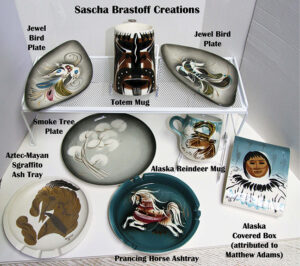 Article and Photos By Tom Cotter
Article and Photos By Tom Cotter As previously threatened, I’m providing this companion piece to my article in the August 5, 2021 Mountain States Collector on Mid-Century Modern ceramics in the U.S from eastern companies. There were not a large number of established works in the west of the Mississippi in 1940, and not many of those produced significant amounts of china, artworks, or tableware. Several started out as makers of sewer pipes and patio/outdoor pots, transitioning to finer wares as the population boomed. But between 1940 and 1970, the population in the West grew from just over 14 million to nearly 38 million. This growing number of Western residents had new tastes and homes, with a drier and barer landscape to match with their decor. A number of new companies along with a few older ones blossomed to fill those desires. Post-War America took to the highways with an automotive boom, gulping up souvenirs along the way. Within this context, I present Western companies by the states in which they produced their wares. Between the Mississippi and the Rocky Mountains, several art and decorative potteries or souvenir companies flourished. In Arkansas, Camark Pottery was made with a variety of ornamental pieces. In 1946, and nearby, Jim Dryden moved his pottery to Hot Springs from its souvenir foundations in Kansas. In Texas, Alamo Pottery made attractive pottery from 1945 to about 1951 but gave way to Gilmer when the company was sold in 1951. Of course, Hot Springs and San Antonio were significant tourist meccas after the war. With quality clay deposits and creative artists, Oklahoma served as home to several exceptional art potteries, all near Tulsa and major highways, e.g. Route 66. Probably the most recognizable was Frankoma, with earthy tones and a variety of Western concepts in serving and decorative pieces. 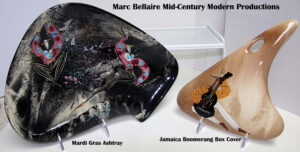 Frankoma dinnerware included names like Plainsman, Wagon Wheel, Mayan Aztec, and Ranch in colors of Prairie Green, Desert Gold, and Woodland Moss. Tamac offered uniquely formed pieces in subtle organic shapes and hues. Flora Hammat and family designed and made extraordinary pieces from figurines to biomorphic ashtrays and serving pieces with interiors of shining, multi-hued mother-of-pearl surrounded by sandy exteriors. Adding to the Sooner variety were Winart and Synar, generating various unique souvenir pieces. South Dakota introduced Pine Ridge Pottery, a variety of Sioux-produced pieces growing out of a WPA project from the University of North Dakota. Beware of bogus “Pine Ridge Pottery” made in China! North Dakota joined the ceramics surge with Laura Taylor Hughes-designed Rosemeade Pottery offering mostly souvenir animals, often salt and pepper shaker sets, but also ashtrays, vases, small bowls, and sugars and creamers, including 19 different pheasant figurines. Short-lived Ceramics by Messer and Little Heart Ceramics made a variety of quality figures including pronghorn and cattle, as well as trays, vases, and cups. Between the Rocky and the Sierra Nevada Mountains, MCM ceramics making was limited, with several companies in Arizona. In the 1950s and 1960s California transplant La Solana Pottery offered a full range of kitchen and serving pieces in primarily pastel hues of turquoise, sage/green, yellow, pink/beige/rose, and some sets with different color lids or with unique decorations. Rosemary’s Ceramics in Mesa produced a variety of souvenir and decorative items from about 1954 into the 1960’s, often with Southwestern and native subject matter. Down the road in Tucson, Kay Mallek Studios began in 1947, manufacturing and decorating souvenir pieces. Mallek’s wares drew on a number of concepts, including desert animals and cacti, Mimbres Indian designs, and a series of Christmas plates with native motifs.
Frankoma dinnerware included names like Plainsman, Wagon Wheel, Mayan Aztec, and Ranch in colors of Prairie Green, Desert Gold, and Woodland Moss. Tamac offered uniquely formed pieces in subtle organic shapes and hues. Flora Hammat and family designed and made extraordinary pieces from figurines to biomorphic ashtrays and serving pieces with interiors of shining, multi-hued mother-of-pearl surrounded by sandy exteriors. Adding to the Sooner variety were Winart and Synar, generating various unique souvenir pieces. South Dakota introduced Pine Ridge Pottery, a variety of Sioux-produced pieces growing out of a WPA project from the University of North Dakota. Beware of bogus “Pine Ridge Pottery” made in China! North Dakota joined the ceramics surge with Laura Taylor Hughes-designed Rosemeade Pottery offering mostly souvenir animals, often salt and pepper shaker sets, but also ashtrays, vases, small bowls, and sugars and creamers, including 19 different pheasant figurines. Short-lived Ceramics by Messer and Little Heart Ceramics made a variety of quality figures including pronghorn and cattle, as well as trays, vases, and cups. Between the Rocky and the Sierra Nevada Mountains, MCM ceramics making was limited, with several companies in Arizona. In the 1950s and 1960s California transplant La Solana Pottery offered a full range of kitchen and serving pieces in primarily pastel hues of turquoise, sage/green, yellow, pink/beige/rose, and some sets with different color lids or with unique decorations. Rosemary’s Ceramics in Mesa produced a variety of souvenir and decorative items from about 1954 into the 1960’s, often with Southwestern and native subject matter. Down the road in Tucson, Kay Mallek Studios began in 1947, manufacturing and decorating souvenir pieces. Mallek’s wares drew on a number of concepts, including desert animals and cacti, Mimbres Indian designs, and a series of Christmas plates with native motifs.
 Frankoma dinnerware included names like Plainsman, Wagon Wheel, Mayan Aztec, and Ranch in colors of Prairie Green, Desert Gold, and Woodland Moss. Tamac offered uniquely formed pieces in subtle organic shapes and hues. Flora Hammat and family designed and made extraordinary pieces from figurines to biomorphic ashtrays and serving pieces with interiors of shining, multi-hued mother-of-pearl surrounded by sandy exteriors. Adding to the Sooner variety were Winart and Synar, generating various unique souvenir pieces. South Dakota introduced Pine Ridge Pottery, a variety of Sioux-produced pieces growing out of a WPA project from the University of North Dakota. Beware of bogus “Pine Ridge Pottery” made in China! North Dakota joined the ceramics surge with Laura Taylor Hughes-designed Rosemeade Pottery offering mostly souvenir animals, often salt and pepper shaker sets, but also ashtrays, vases, small bowls, and sugars and creamers, including 19 different pheasant figurines. Short-lived Ceramics by Messer and Little Heart Ceramics made a variety of quality figures including pronghorn and cattle, as well as trays, vases, and cups. Between the Rocky and the Sierra Nevada Mountains, MCM ceramics making was limited, with several companies in Arizona. In the 1950s and 1960s California transplant La Solana Pottery offered a full range of kitchen and serving pieces in primarily pastel hues of turquoise, sage/green, yellow, pink/beige/rose, and some sets with different color lids or with unique decorations. Rosemary’s Ceramics in Mesa produced a variety of souvenir and decorative items from about 1954 into the 1960’s, often with Southwestern and native subject matter. Down the road in Tucson, Kay Mallek Studios began in 1947, manufacturing and decorating souvenir pieces. Mallek’s wares drew on a number of concepts, including desert animals and cacti, Mimbres Indian designs, and a series of Christmas plates with native motifs.
Frankoma dinnerware included names like Plainsman, Wagon Wheel, Mayan Aztec, and Ranch in colors of Prairie Green, Desert Gold, and Woodland Moss. Tamac offered uniquely formed pieces in subtle organic shapes and hues. Flora Hammat and family designed and made extraordinary pieces from figurines to biomorphic ashtrays and serving pieces with interiors of shining, multi-hued mother-of-pearl surrounded by sandy exteriors. Adding to the Sooner variety were Winart and Synar, generating various unique souvenir pieces. South Dakota introduced Pine Ridge Pottery, a variety of Sioux-produced pieces growing out of a WPA project from the University of North Dakota. Beware of bogus “Pine Ridge Pottery” made in China! North Dakota joined the ceramics surge with Laura Taylor Hughes-designed Rosemeade Pottery offering mostly souvenir animals, often salt and pepper shaker sets, but also ashtrays, vases, small bowls, and sugars and creamers, including 19 different pheasant figurines. Short-lived Ceramics by Messer and Little Heart Ceramics made a variety of quality figures including pronghorn and cattle, as well as trays, vases, and cups. Between the Rocky and the Sierra Nevada Mountains, MCM ceramics making was limited, with several companies in Arizona. In the 1950s and 1960s California transplant La Solana Pottery offered a full range of kitchen and serving pieces in primarily pastel hues of turquoise, sage/green, yellow, pink/beige/rose, and some sets with different color lids or with unique decorations. Rosemary’s Ceramics in Mesa produced a variety of souvenir and decorative items from about 1954 into the 1960’s, often with Southwestern and native subject matter. Down the road in Tucson, Kay Mallek Studios began in 1947, manufacturing and decorating souvenir pieces. Mallek’s wares drew on a number of concepts, including desert animals and cacti, Mimbres Indian designs, and a series of Christmas plates with native motifs.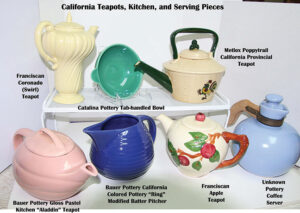 In our own Colorado, ceramics discussion must include Van Briggle of Colorado Springs. While continuing its art pottery tradition, Van Briggle expanded into gloss glazes and more modern designs for post-World War II tastes, with Clem Hull, Fred Wills, and the Stevenson family leading the pottery through most of this period adding new shapes in colors like Ming or Turquoise Blue and Persian Rose. The “Anna” Van Briggle line of gloss-finished distinctly MCM pieces spanned from 1954 to 1968, and, according to Fred Wills, “It was just a way of keeping a problematic line of clay and glaze that we bought from Dryden Pottery separate from the normal Van Briggle clays and glazes.”1 Few older potteries in Colorado survived the upheavals of Depression and War, but Loveland saw both Rocky Mountain Art Pottery (ROMCO) and Loveland Art Pottery companies making primarily mountain/forest-themed pieces for the tourist trade.
In our own Colorado, ceramics discussion must include Van Briggle of Colorado Springs. While continuing its art pottery tradition, Van Briggle expanded into gloss glazes and more modern designs for post-World War II tastes, with Clem Hull, Fred Wills, and the Stevenson family leading the pottery through most of this period adding new shapes in colors like Ming or Turquoise Blue and Persian Rose. The “Anna” Van Briggle line of gloss-finished distinctly MCM pieces spanned from 1954 to 1968, and, according to Fred Wills, “It was just a way of keeping a problematic line of clay and glaze that we bought from Dryden Pottery separate from the normal Van Briggle clays and glazes.”1 Few older potteries in Colorado survived the upheavals of Depression and War, but Loveland saw both Rocky Mountain Art Pottery (ROMCO) and Loveland Art Pottery companies making primarily mountain/forest-themed pieces for the tourist trade. Dozens of companies in California generated a wide variety of ceramics between 1940 and 1970. A couple continue to exist. Since 1959, Heath Ceramics maintains design and production of dinnerware, tile, decorative pieces, and even flatware for home and restaurant, following the vision of Edith Heath in her early lines Coupe and Rim, with a gentle palette and fundamental shapes still greatly in demand. Begun in 1945, Hagen-Reneker is still alive and kicking out intricate miniature figurines, notably horses.
 Former California firms ranged from giants like Bauer, Gladding, McBean & Co., Metlox, and Vernon Kilns to small studio makers like Howard Pierce. Those big four created extensive lines of dinnerware and decorative pieces. Before succumbing to financial pressures in 1958, Vernon Kilns made relatively soft, eye-catching shapes, colors, and decorations mostly in pastels like Early and Modern California, Organdie (plaid), Brown-Eyed Susan, Winchester ’73, San Marino, San Clemente, and Transitional. Besides vases, bowls, and other decorative wares, Vernon specialized in souvenir plates for cities, states (all 48!), colleges and universities, historic persons, National Parks, and special order custom plates. Hollywood figures immortalized by Vernon Kilns included Sally Rand, Gary Cooper, Dorothy Lamour, and Disney characters from Fantasia and Dumbo, all rare and desirable. Although Vernon Kilns ceased to be an independent company, it lived on as a division of Metlox into the late 1970s. Initially using glaze formulas created by Victor Houser around 1930, J.A. Bauer pioneered colors that revolutionized California’s ceramics industry. As talc became used in the 1930s to make higher quality bodies and glazes, Bauer and others improved vitrification and reduced crazing. With their Louis Ipsen-designed “Ring” line coming out in 1933, Bauer’s styles dovetailed perfectly with the new styles in houses and furniture. A new line called Monterey heralded post-war production of La Linda, Monterey Moderne, and Brusché Al Fresco. Formulated by Houser due to War material shortages, new brilliant glazes included burgundy, Chinese yellow, Delph blue, ivory, jade green, orange-red, royal blue, and rare black and white. Tracy Irwin created a number of bowls, vases, and ashtrays with unique shapes and colors in the 1950s. Nevertheless, by 1961 market loss and a labor strike led to closure of the firm. Gladding, McBean & Co., expanded into art pottery and Franciscan dinnerware in the late 1930s. Metropolitan, later Tiempo, preceded true fine Masterpiece China, and the informal Discovery design. In 1940, hand-painted, embossed Apple earthenware hit the market, with Desert Rose and Ivy coming soon after as major contributors to the company’s success for several decades. The epitome of Mid-Century Modern emerged from Gladding, McBean in 1954 with the George James’ Eclipse shape in patterns Eclipse White, Pomegranate, and, most notably, Starburst, a decoration from the imagination of Mary Chalmers Brown. The Contour line followed shortly. Nostalgic Apple and Desert Rose contrasted with atom-flavored Starburst and the muted shades of Contour. Evan Shaw was the driving force behind Metlox (metal oxide) beginning in 1946. Shaw differentiated Metlox from the other by-then Big Four, producing hand-painted designs by Bob Allen and Mel Shaw. Beginning with California Ivy, dinnerware was produced and marketed as Poppytrail. Significant lines were Ivy, Provincial, with its embossed “rivets,” Shoreline, Confetti, Tempo with Navajo design, and Frank Irwin’s Freeform shapes with the Aztec pattern by Bob Allen, accompanying Irwin’s California Contempora, Freeform, and Mobile as Metlox’s avant-garde motifs that embodied MCM.
Former California firms ranged from giants like Bauer, Gladding, McBean & Co., Metlox, and Vernon Kilns to small studio makers like Howard Pierce. Those big four created extensive lines of dinnerware and decorative pieces. Before succumbing to financial pressures in 1958, Vernon Kilns made relatively soft, eye-catching shapes, colors, and decorations mostly in pastels like Early and Modern California, Organdie (plaid), Brown-Eyed Susan, Winchester ’73, San Marino, San Clemente, and Transitional. Besides vases, bowls, and other decorative wares, Vernon specialized in souvenir plates for cities, states (all 48!), colleges and universities, historic persons, National Parks, and special order custom plates. Hollywood figures immortalized by Vernon Kilns included Sally Rand, Gary Cooper, Dorothy Lamour, and Disney characters from Fantasia and Dumbo, all rare and desirable. Although Vernon Kilns ceased to be an independent company, it lived on as a division of Metlox into the late 1970s. Initially using glaze formulas created by Victor Houser around 1930, J.A. Bauer pioneered colors that revolutionized California’s ceramics industry. As talc became used in the 1930s to make higher quality bodies and glazes, Bauer and others improved vitrification and reduced crazing. With their Louis Ipsen-designed “Ring” line coming out in 1933, Bauer’s styles dovetailed perfectly with the new styles in houses and furniture. A new line called Monterey heralded post-war production of La Linda, Monterey Moderne, and Brusché Al Fresco. Formulated by Houser due to War material shortages, new brilliant glazes included burgundy, Chinese yellow, Delph blue, ivory, jade green, orange-red, royal blue, and rare black and white. Tracy Irwin created a number of bowls, vases, and ashtrays with unique shapes and colors in the 1950s. Nevertheless, by 1961 market loss and a labor strike led to closure of the firm. Gladding, McBean & Co., expanded into art pottery and Franciscan dinnerware in the late 1930s. Metropolitan, later Tiempo, preceded true fine Masterpiece China, and the informal Discovery design. In 1940, hand-painted, embossed Apple earthenware hit the market, with Desert Rose and Ivy coming soon after as major contributors to the company’s success for several decades. The epitome of Mid-Century Modern emerged from Gladding, McBean in 1954 with the George James’ Eclipse shape in patterns Eclipse White, Pomegranate, and, most notably, Starburst, a decoration from the imagination of Mary Chalmers Brown. The Contour line followed shortly. Nostalgic Apple and Desert Rose contrasted with atom-flavored Starburst and the muted shades of Contour. Evan Shaw was the driving force behind Metlox (metal oxide) beginning in 1946. Shaw differentiated Metlox from the other by-then Big Four, producing hand-painted designs by Bob Allen and Mel Shaw. Beginning with California Ivy, dinnerware was produced and marketed as Poppytrail. Significant lines were Ivy, Provincial, with its embossed “rivets,” Shoreline, Confetti, Tempo with Navajo design, and Frank Irwin’s Freeform shapes with the Aztec pattern by Bob Allen, accompanying Irwin’s California Contempora, Freeform, and Mobile as Metlox’s avant-garde motifs that embodied MCM.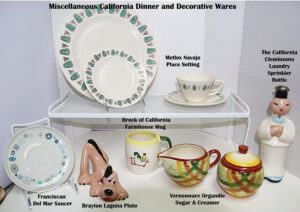 The California Cleminsons offered useful and colorful housewares such as figural ironing sprinkler bottles, Pinocchio toothbrush holders (after he lied!), spoon rests, egg timers, wall hangers with pithy sayings, and pie birds to let off steam during baking. Hedi Schoop’s theatrical creations experienced great demand, but a fire in 1958 ended her manufacturing. Trained ceramic artist Kay Finch took the advice of her professor, noted ceramicist William Manker, generating a line of quality animals, often cutesy, AKC–inspired dogs, and delicate, ornately dressed people. Betty Lou Nichols developed exceptionally detailed period figures and head vases. Betty Lou’s head vases were highlighted by intricate eyelashes, bows, lace, and luxurious hair. Freeman-McFarlin created animals and exotic creatures such as centaurs and mermaids from the late 1920s into the 1970s. They also developed a variety of household decor and incorporated some late animal designs by Kay Finch after her business closure. Another Manker-trained artist was Howard Pierce, who never expanded beyond what he, his family, and occasional paid help could do at his home studio very successfully for over 50 years. Partnering with artist wife Ellen, Pierce’s mastery at developing stylized but instantly recognizable figures in singles, pairs, and groups of animals, select people such as angels, children, and “natives,” and decorative pieces epitomized artwork that generated high demand across the country. My article “Howard Pierce: Treasured Pottery for All” is available in the Mountain States Collector archives from September 6, 2017. Florence Ceramics, the inspiration of Florence Ward, grew from a garage into a 10,000 square foot factory producing intricately detailed period figures with characters often inspired by the Victorian era Godey’s Lady’s Book. Special Florence figures included French kings and queens, Scarlett and Rhett, Gibson Girls, and mermaids, birds, and children. Roselane Pottery offered classically styled animal and human figures, as well as whimsical animals with rhinestone or plastic “Sparkler” eyes. Brad Keeler’s exotic birds (including flamingos, pheasants, and cockatoos), lobsters, and cats displayed attention to detail and quality that unfortunately ended with his death in 1952. Brayton Laguna made many figures and accessories, becoming known for Walt Disney characters such as Bambi, Donald, Mickey, Minnie, and Pluto. Virgil Haldeman’s Caliente Pottery used his unique matte and gloss glazes to create high-demand bowls, baskets, candleholders, ash trays, and figures. Twin Winton made mostly farcical figures and cookie jars. Smaller companies included DeLee Art, with hand decorated small animals, especially skunks, and other art ware. Other figurines came from Clay Sketches, and Claysmiths, both known for their intricate airbrushed birds and animals. Claire Lerner generated green, pink, and grey decorative pieces, often leaf-shaped. Stewart B. McCulloch made decorative horses, Asian, Dutch, and U.S. children planters, and deer. Chain stores and stamp premium companies carried Maddux of California’s birds, cats, ashtrays, and bowls. Some of the Maddux ashtrays appeared in MCM colors like stunning lava, glaring avocado, and unsympathetic chartreuse (author’s adjectives). Southern California Pottery by Brock offered tasteful dinnerware lines with labels such as Chanticleer, Desert Mist, Manzanita, and Harvest. Wallace China’s Western themes including Boot and Saddle, Rodeo, and Little Buckaroo were very popular in the 1940s and 1950s. Winfield Pottery maintained an exotic flair with Dragon Flower, Bird of Paradise, Blue Pacific, and other decorations. With a variety of distinctive glazes in chartreuse, turquoise, yellow, coral, and bright red, contemporary designs, and often a crackle finish, Barbara Willis successfully built a following and lingering demand.
The California Cleminsons offered useful and colorful housewares such as figural ironing sprinkler bottles, Pinocchio toothbrush holders (after he lied!), spoon rests, egg timers, wall hangers with pithy sayings, and pie birds to let off steam during baking. Hedi Schoop’s theatrical creations experienced great demand, but a fire in 1958 ended her manufacturing. Trained ceramic artist Kay Finch took the advice of her professor, noted ceramicist William Manker, generating a line of quality animals, often cutesy, AKC–inspired dogs, and delicate, ornately dressed people. Betty Lou Nichols developed exceptionally detailed period figures and head vases. Betty Lou’s head vases were highlighted by intricate eyelashes, bows, lace, and luxurious hair. Freeman-McFarlin created animals and exotic creatures such as centaurs and mermaids from the late 1920s into the 1970s. They also developed a variety of household decor and incorporated some late animal designs by Kay Finch after her business closure. Another Manker-trained artist was Howard Pierce, who never expanded beyond what he, his family, and occasional paid help could do at his home studio very successfully for over 50 years. Partnering with artist wife Ellen, Pierce’s mastery at developing stylized but instantly recognizable figures in singles, pairs, and groups of animals, select people such as angels, children, and “natives,” and decorative pieces epitomized artwork that generated high demand across the country. My article “Howard Pierce: Treasured Pottery for All” is available in the Mountain States Collector archives from September 6, 2017. Florence Ceramics, the inspiration of Florence Ward, grew from a garage into a 10,000 square foot factory producing intricately detailed period figures with characters often inspired by the Victorian era Godey’s Lady’s Book. Special Florence figures included French kings and queens, Scarlett and Rhett, Gibson Girls, and mermaids, birds, and children. Roselane Pottery offered classically styled animal and human figures, as well as whimsical animals with rhinestone or plastic “Sparkler” eyes. Brad Keeler’s exotic birds (including flamingos, pheasants, and cockatoos), lobsters, and cats displayed attention to detail and quality that unfortunately ended with his death in 1952. Brayton Laguna made many figures and accessories, becoming known for Walt Disney characters such as Bambi, Donald, Mickey, Minnie, and Pluto. Virgil Haldeman’s Caliente Pottery used his unique matte and gloss glazes to create high-demand bowls, baskets, candleholders, ash trays, and figures. Twin Winton made mostly farcical figures and cookie jars. Smaller companies included DeLee Art, with hand decorated small animals, especially skunks, and other art ware. Other figurines came from Clay Sketches, and Claysmiths, both known for their intricate airbrushed birds and animals. Claire Lerner generated green, pink, and grey decorative pieces, often leaf-shaped. Stewart B. McCulloch made decorative horses, Asian, Dutch, and U.S. children planters, and deer. Chain stores and stamp premium companies carried Maddux of California’s birds, cats, ashtrays, and bowls. Some of the Maddux ashtrays appeared in MCM colors like stunning lava, glaring avocado, and unsympathetic chartreuse (author’s adjectives). Southern California Pottery by Brock offered tasteful dinnerware lines with labels such as Chanticleer, Desert Mist, Manzanita, and Harvest. Wallace China’s Western themes including Boot and Saddle, Rodeo, and Little Buckaroo were very popular in the 1940s and 1950s. Winfield Pottery maintained an exotic flair with Dragon Flower, Bird of Paradise, Blue Pacific, and other decorations. With a variety of distinctive glazes in chartreuse, turquoise, yellow, coral, and bright red, contemporary designs, and often a crackle finish, Barbara Willis successfully built a following and lingering demand.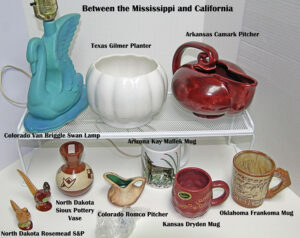 Two companies really, really embodied the Modern in MCM, beginning with Sascha Brastoff. Brastoff was a larger than life character, with connections to the Rockefellers and Hollywood greats like Zsa Zsa, Mitzi, and Edward G. Though fragile, his colorful works ranged from totems to pagodas, bejeweled birds and horses, fruits and flowers, and an Alaska series (designed by Matthew Adams). Brastoff’s works were sometimes muted, but never bashful. A Brastoff protégé, Marc Bellaire, created impassioned artworks like Mardi Gras, Jamaica, Bali, and Beachcomber, alive with colors, textured backgrounds, and figures in motion.
Two companies really, really embodied the Modern in MCM, beginning with Sascha Brastoff. Brastoff was a larger than life character, with connections to the Rockefellers and Hollywood greats like Zsa Zsa, Mitzi, and Edward G. Though fragile, his colorful works ranged from totems to pagodas, bejeweled birds and horses, fruits and flowers, and an Alaska series (designed by Matthew Adams). Brastoff’s works were sometimes muted, but never bashful. A Brastoff protégé, Marc Bellaire, created impassioned artworks like Mardi Gras, Jamaica, Bali, and Beachcomber, alive with colors, textured backgrounds, and figures in motion. But all good things must end, and U.S. Mid-Century Modern declined in the 1960s and 1970s amid changing tastes, cheap imports, and plastic. Come indulge your own interests at the Front Range Glass Show Saturday and Sunday, October 2 and 3, 2021, at the Ranch Events Complex near Loveland, presented by Jodi and Mark Uthe. There will be a whole lot of period glass, pottery, and china. Yes, a bunch of Mid-Century Modern. The Rocky Mountain Depression Glass Society offers great ways to learn and collect and the Society will have a booth at the Front Range Glass Show, with members, including myself, offering information and insight into the local collecting as well as fascinating items for sale. Find or indulge your own passion. Nothing can provide much better visual and mental stimulation than a day at Kirkland Museum of Fine and Decorative Arts, scheduled to re-open later this month. Visit shops advertising in our Mountain States Collector, published by friends Peggy and Jon DeStefano. NOTE: Bibliography available on request. Footnotes: 1“Anna Van – The True Story”. Wills, Fred and Shonk, Elizabeth. https://www.clemhull.com/Anna%20Van.html, 2005.















Follow Us